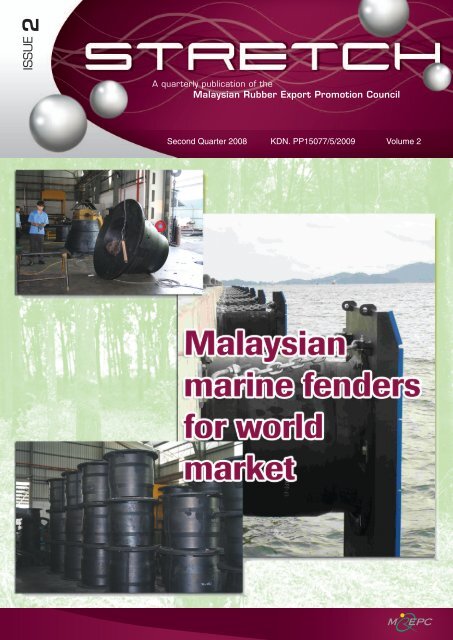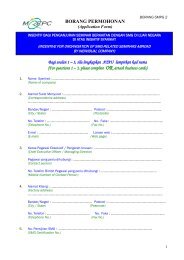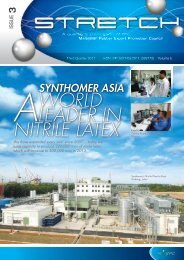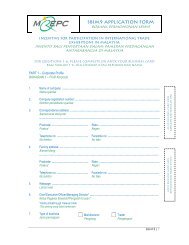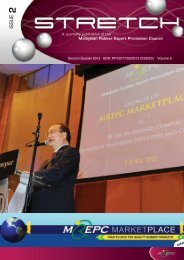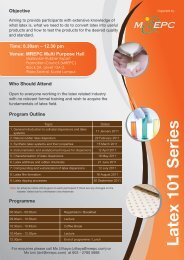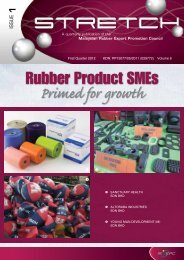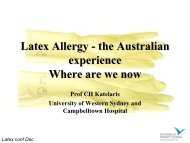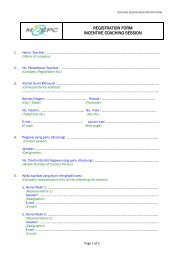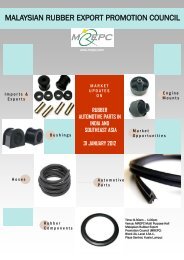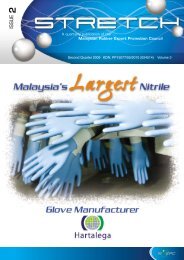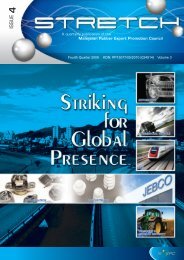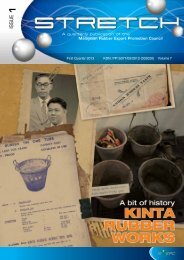You also want an ePaper? Increase the reach of your titles
YUMPU automatically turns print PDFs into web optimized ePapers that Google loves.
ISSUE 2<br />
A quarterly publication of the<br />
Malaysian Rubber Export Promotion Council<br />
Second Quarter 2008 KDN. PP15077/5/2009 Volume 2
Contents<br />
From the CEO’s Desk 2<br />
Trade Fairs/Exhibitions 3<br />
NHS National Guideline 7<br />
Latex-free vs. Latex-safe 8<br />
Malaysian-made Marine<br />
Fenders 10<br />
Trade Statistics 14<br />
Seminars/Workshops 15<br />
Commentary 17<br />
Travelogue – Dubai 18<br />
Editor-in-Chief:<br />
DATO’ TEO SUAT CHENG<br />
Editor:<br />
DR. LIM CHONG LIAN<br />
For comments, enquiries and<br />
advertisements, please contact:<br />
The Editor<br />
MREPC<br />
Block 2A, Level 13A-1<br />
Plaza Sentral<br />
Jalan Stesen Sentral 5<br />
50470 Kuala Lumpur<br />
Malaysia<br />
Tel : 603-27805888<br />
Fax : 603-27805088<br />
E-mail : cllim@mrepc.com<br />
Website : www.mrepc.com<br />
Printed by:<br />
KSB PRINT SDN BHD<br />
No. 18, Lingkaran Industri<br />
Taman Cheras Emas<br />
43200 Cheras, Selangor<br />
The contents of this publication are<br />
<strong>copy</strong>rights of MREPC, unless otherwise<br />
indicated, and no part may be reproduced<br />
or transmitted in any form or by any means,<br />
without the prior written permission from<br />
MREPC.<br />
2<br />
FROM THE CEO’S DESK<br />
CEO of MREPC Dato’ Teo Suat Cheng<br />
Earthquakes are among the world’s feared natural disasters, bringing<br />
death and destruction whenever they occur. Continents sit on<br />
tectonic plates which are in a constant state of flux, and no one<br />
knows for certain when the next big earthquake will strike. Despite<br />
advancement in technology, prediction of when earthquakes may<br />
occur is still very much in its infancy, and current developments suggest that<br />
the best protection lies in providing dwellings which are safe for people to<br />
be in when earthquakes occur.<br />
For countries unfortunate enough to be in close proximity with faults, which<br />
are the loci of earthquakes, it is imperative that buildings and dwellings be<br />
constructed to withstand the forces of these tremors. It is in this area that<br />
technology has made progress and, indeed, it is possible to isolate dwellings,<br />
including those for public housing, from such destructive forces.<br />
One such technology is base or seismic isolation of buildings and bridges<br />
with laminated rubber bearings. The isolation with high-damping natural<br />
rubber bearings was pioneered by the Malaysian Rubber Board working in<br />
collaboration with the Earthquake Engineering Research Centre at Berkeley<br />
in the 1980s, and to date, numerous buildings have been isolated successfully<br />
from earthquakes in many parts of the world.<br />
Our hearts go out to the people of Sichuan Province in the Republic of<br />
China, who recently suffered the devastation of a Richter 7.9 earthquake,<br />
which claimed the lives of tens of thousands. We share your grief and your<br />
suffering. If there is comfort, we hope that future buildings and dwellings<br />
could be isolated using rubber bearings to protect property and lives during<br />
such calamities. The system is not expensive, and the saving of even one life<br />
would be an immeasurable return on investment in the technology.
Arab Health 2008<br />
(28-31 January 2008)<br />
MREPC participated for the<br />
first time at the Arab Health<br />
2008 Exhibition and Congress<br />
held in Dubai, UAE (United<br />
Arab Emirates). The MREPC<br />
booth was located at the<br />
Malaysian Pavilion together<br />
with MATRADE and 23 other<br />
Malaysian exhibitors. Seven<br />
companies participated under<br />
the MREPC umbrella, and they<br />
were AB Worldwide, Adventa<br />
Health, Duramedical, Kossan<br />
Latex Industries, Latexx<br />
Manufacturing, Rubberex<br />
and Uro Technology. Other<br />
participating Malaysian rubber<br />
glove manufacturers were Top<br />
Glove and Hartalega.<br />
MREPC’s participation<br />
at the event was part of<br />
its efforts to promote<br />
the export of Malaysianmade<br />
rubber medical<br />
products to the emerging<br />
M i d d l e E a s t m a r k e t<br />
by establishing good<br />
linkages between relevant<br />
Malaysian manufacturers<br />
and buyers from the<br />
region. Strong interests<br />
were shown on Malaysian<br />
latex examination and<br />
surgical gloves. The<br />
five participating glove<br />
companies were generally<br />
happy about the high<br />
TRADE FAIRS/EXHIBITIONS<br />
Entrance to Arab Health 2008<br />
The largest healthcare<br />
exhibition in the<br />
Middle East<br />
Malaysian rubber product exhibitors at the Malaysian Pavilion<br />
number of enquiries<br />
received. Some were<br />
confident that there<br />
would be sales in the near<br />
future arising from their<br />
participation at this trade<br />
fair.<br />
Ranked as the largest<br />
healthcare exhibition<br />
in the Middle East and<br />
the second largest in the<br />
world, Arab Health 2008<br />
attracted 2,085 exhibitors<br />
and more than 50,000<br />
trade visitors, largely from<br />
Europe and the GCC (Gulf<br />
Cooperation Countries).<br />
3
International Auto Aftermarket (IAAE 2008), Tokyo<br />
(13-15 March 2008)<br />
MREPC participated at the 7 th IAAE from 13 to15 March<br />
in Tokyo, Japan. The IAAE was held at the “Tokyo Big<br />
Sight” Convention Centre. It showcased auto repair and<br />
maintenance products, diagnostic equipment, car washing<br />
and cleaning equipment, interior decoration parts, auto<br />
accessories, car safety and security devices, body-coating<br />
products and other automotive-related products.<br />
The Malaysian delegation comprising 12 manufacturers<br />
was led by MATRADE with support from JETRO.<br />
Automotive parts manufacturers were invited to<br />
participate in this exhibition. Rubber automotive parts<br />
manufacturers were represented by Pong Codan Rubber<br />
(M) Sdn. Bhd., MALCORP and Kumpulan Jebco (M) Sdn.<br />
Bhd., while MREPC shared a booth with MATRADE.<br />
Prior to the exhibition, JETRO-MATRADE organized a<br />
two-day factory visit to the Toyota manufacturing plant<br />
(Tsutsumi plant) and Toyoda Gosei (Morimachi plant),<br />
the in-house supplier of auto parts for Toyota, Japan. The<br />
Toyota head office is located in Aichi Prefecture.<br />
The Malaysian delegation had the opportunity to witness<br />
the entire process of how cars are made.<br />
Although the Japanese market is not an easy one, IAAE<br />
2008 provided a platform for Malaysian companies to<br />
showcase their products, find new business opportunities<br />
and rekindle business ties with their existing customers.<br />
MREPC sharing a booth with MATRADE<br />
4<br />
The Malaysian delegation with staff from JETRO<br />
and MATRADE<br />
Toyota showroom<br />
Pong Codan’s booth
Interzum, Guangzhou<br />
(27-30 March 2008)<br />
Interzum, held in Guangzhou, China, from 27<br />
to 30 March 2008, is Asia’s most comprehensive<br />
woodworking machinery and furniture production<br />
trade fair. Organized for the 5 th time at the Guangzhou<br />
International Convention And Exhibition Centre, the<br />
show attracted 688 exhibitors consisting of 481 local<br />
companies and 207 international companies from 23<br />
countries. The number of exhibitors has increased by<br />
more than 35% compared to the previous exhibition<br />
held in 2007.<br />
Interzum Guangzhou attracted over 57,073 trade<br />
visitors from 137 countries representing buyers from<br />
various sectors including furniture manufacturing,<br />
wood and plastic processing, wood and plastic trading,<br />
interior design and furniture wholesale and retail.<br />
A bilingual seminar on technology, woodworking and<br />
innovation was also held alongside the exhibition.<br />
Three Malaysian latex foam manufacturers participated<br />
at Interzum Guangzhou 2008, with assistance from<br />
MREPC. They were Aerofoam Industry (1969) Sdn.<br />
Bhd., Mattressworld Industries (M) Sdn. Bhd. and<br />
Weifong Industries Sdn. Bhd. The manufacturers<br />
participated at this exhibition to seek trade and<br />
investment opportunities and to establish relationships<br />
with Chinese and other foreign buyers.<br />
The majority of enquiries received by the manufacturers<br />
were for latex foam mattresses, pillows and sheetings.<br />
The Chinese market was perceived as having good<br />
potential for the products exhibited and the trade<br />
inquiries received were considered to be useful leads.<br />
It was also indicated that there was interest from some<br />
European visitors to the Malaysian booths. Mattresses<br />
made of 100% natural latex were among the products<br />
that attracted most interests.<br />
The manufacturers agreed that despite potential<br />
challenges, China appears to be an attractive market<br />
for Malaysian manufacturers.<br />
Aerofoam’s booth<br />
Mattressworld’s booth<br />
Weifong’s booth<br />
5
Ekspo Komoditi 2008, Miri, Sarawak<br />
(22-29 March 2008)<br />
MREPC participated at the<br />
“Ekspo Komoditi (Commodity<br />
Expo) 2008”, held for the first<br />
time this year. This event was<br />
organized by the Ministry<br />
of Plantation Industries and<br />
Commodities with the aim<br />
to create awareness among<br />
the public on the role and<br />
functions of the plantation<br />
and commodities sector in<br />
Malaysia. The event was<br />
held in Miri, Sarawak, at the<br />
Imperial Hotel Miri from 22<br />
to 24 February and at the<br />
Dewan Suarah Miri from 25<br />
to 29 February.<br />
T h e e x p o , w i t h i t s t h e m e<br />
“Achievements and Opportunities<br />
in the Commodity Sector”,<br />
highlighted recent developments<br />
in technology and products as<br />
well as other innovations in the<br />
commodities sector, namely rubber,<br />
palm oil, timber, cocoa, pepper and<br />
tobacco.<br />
MREPC exhibited a wide range of<br />
products from latex based products<br />
to dry rubber products, including<br />
SMG gloves, catheters and other<br />
medical devices, rubber automotive<br />
components, precured treads, sports<br />
items, general rubber goods, and<br />
industrial rubber goods.<br />
6<br />
In addition to the display of<br />
rubber products, MREPC also<br />
organized various activities to draw<br />
the attention of visitors and educate<br />
the public on the contributions of<br />
the rubber products sector to<br />
the Malaysian<br />
economy.<br />
T h e E k s p o<br />
Komoditi 2008<br />
provided an<br />
o p p o r t u n i t y<br />
f o r M R E P C<br />
to inform the<br />
M a l a y s i a n<br />
p u b l i c ,<br />
specifically the<br />
The Minister at the opening of “Ekspo Komoditi 2008”<br />
people of Sarawak, about the role<br />
and functions of the Council and<br />
how the rubber products sector<br />
has contributed to development<br />
in Malaysia.<br />
Visitors to the MREPC booth
NHS NATIONAL GUIDELINE<br />
Latex Allergy:<br />
Occupational aspects of management - A national guideline<br />
The Royal College of Physicians and NHS Plus, a network of NHS occupational health departments which is based<br />
in London, have come up with a latest 2008 report entitled “Latex Allergy: Occupational aspects of management.<br />
A national guideline,” which concluded that switching to powder-free gloves “significantly reduces latex allergy<br />
and latex-induced asthma.”<br />
Although there is a large body of research on latex allergy, few studies have examined occupational health<br />
interventions as comprehensively as this one. The review was carried out using evidence-based guidelines. The<br />
Guideline Development Group was led by Dr. Syed M. Ahmed, Specialist Registrar in Occupational Medicine, East<br />
Kent Hospitals Trust, and the 14 members of the group consisted of leading experts in the fields of latex allergy,<br />
occupational physicians, dermatologists, surgeons and health nurses.<br />
The Guideline Development Group Leader, along with two senior members of the group, reviewed a total of 3,724<br />
abstracts over the period 1997 to 2006, of which 133 papers that were related to the key questions were selected<br />
for full review by the Guideline Development Group. This number was reduced to 47 as papers that met critical<br />
appraisal criteria for inclusion as evidence and ultimately the number of papers used as the basis for the guideline<br />
recommendations totalled 40.<br />
Although the guideline recommends that employees with a latex allergy use non-latex gloves, it does not advocate<br />
a complete ban on latex gloves.<br />
The key findings and recommendations are:<br />
• The use of powder-free, low protein latex gloves as an alternative to powdered latex gloves significantly<br />
reduces the incidence of latex allergy and latex-induced asthma, as well as the prevalence of latex-related<br />
symptoms. Powdered latex gloves should therefore not be used in the workplace.<br />
• At a national and local level, a policy that encourages switching from powdered latex gloves to powderfree<br />
low protein latex gloves is a proven effective method of reducing the incidence of latex allergy.<br />
• Employees with latex allergy, latex sensitivity or latex-induced asthma should use non-latex gloves.<br />
• In employees who are latex allergic/sensitized, taking latex avoidance measures results in cessation or<br />
diminution of symptoms. Markers of sensitization decrease regardless of whether co-workers continue<br />
to use powder-free low protein latex gloves or latex-free gloves.<br />
• In employees with latex-induced asthma or rhinitis, the use of powder-free low protein gloves by their<br />
colleagues reduces symptoms and indices of severity in the affected employee to a similar degree as the<br />
use of non-latex gloves by colleagues.<br />
• All but the most severe cases of latex allergy and latex-induced asthma can be managed without the<br />
need for redeployment, ill health retirement or termination of employment. Adjustments include careful<br />
personal avoidance of latex at work and minor changes in the workplace<br />
• There is a lack of published primary research comparing occupational interventions for those who are<br />
sensitized to latex (without symptoms), with those with clinical latex allergy.<br />
• No reports of new cases of latex allergy arising from non-powdered low protein latex glove use were<br />
found.<br />
7
The Guideline concluded that “the evidence does not therefore support a complete ban on the use of latex gloves.<br />
Institutions should judge whether their needs would be met better by the use of latex-free or powder-free latex<br />
gloves, or use of both in different settings, while taking into account the desirable and undesirable properties of<br />
both materials.”<br />
There is no question whatsoever that the most important fi nding is detailed in the last bullet point, namely that<br />
‘no reports of new cases of latex allergy arising from non-powdered low protein latex glove use were found’. In<br />
other words, the use of powdered-free low protein NR latex gloves has been proven to be perfectly safe in the area<br />
of occupational health.<br />
(Source: NHS Plus, Royal College of Physicians, Faculty of Occupational Medicine. Latex Allergy: occupational aspects of management. A<br />
national guideline. London: RCP, 2008. Copyright © 2008 Royal College of Physicians. Adapted by permission).<br />
For the full report, see http://www.rcplondon.ac.uk/pubs/contents/f0ba178-f790-48e8-a764-b319357f974a.pdf<br />
8<br />
LATEX-FREE VS. LATEX-SAFE<br />
<strong>Issue</strong>s managers should consider | By Anita Shoup, RN, MSN, CNOR<br />
Latex allergies have been a concern in the healthcare environment for<br />
nearly two decades and can be a serious problem for patients and<br />
healthcare workers.<br />
Today the question is: Do healthcare facilities need to go “latex-free”?<br />
Some believe that replacing latex gloves with non-latex gloves will create<br />
a latex-free environment that is safer for patients and workers with<br />
latex allergies. However, because natural rubber latex can be found in<br />
more than 17,600 medical devices, one can begin to understand that<br />
simply replacing latex gloves with latex-free gloves is only the beginning.<br />
While it is considered impossible to remove all latex from the<br />
environment, when caring for a latex allergic individual any source of<br />
latex that could potentially contact the individual should be removed.<br />
Anita Shoup, RN, MSN, CNOR<br />
Clinical Nurse Consultant<br />
Gloves are an essential component of patient care necessary to ensure<br />
workplace safety in healthcare environments. With the prevalence today<br />
of bloodborne pathogens such as HIV, Hepatitis B, and Hepatitis C, barrier protection is critical for<br />
healthcare workers. Workers now need to presume that any patient who presents to a healthcare facility<br />
for treatment may be infected with a bloodborne pathogen, and healthcare workers need to wear the best<br />
protection available.<br />
When making the decision regarding latex-safe (powder-free, low protein gloves) versus “latexfree” (use<br />
of non-latex gloves), facilities must weigh all considerations.
RUBBER PRODUCT TRADE<br />
STATISTICS<br />
Although the quality of non-latex gloves has improved in recent years, many healthcare practitioners prefer<br />
latex gloves because the non-latex gloves may not feel as soft and pliable. Non-latex gloves also do not<br />
come in all the varieties workers need, including thicker, thinner, less textured and more textured. Healthcare<br />
workers generally prefer the characteristics associated with latex gloves for their durability, quality,<br />
safety and needlestick injury prevention.<br />
Double gloving may also be more difficult with non-latex gloves. This may lead some healthcare workers<br />
to forego double gloving when they should be doing so for all invasive procedures, as stated in AORN’s<br />
Recommended Practices for Prevention of Transmissible Infections.<br />
Instead of converting to non-latex gloves, many healthcare organizations are opting to use low-protein,<br />
powder-free latex gloves, creating a “latex-safe” environment. Gloves labelled “low-protein” must meet<br />
standards required by the federal government. In a latex-safe environment, non-latex gloves and other nonlatex<br />
products are used when caring for patients and healthcare workers with known or suspected latex<br />
allergies, and powder-free, low-protein gloves are available for everyone else.<br />
Cost is also a consideration. Although powdered latex gloves are the least expensive option, their typically higher<br />
protein levels may be more likely to cause sensitization and allergic reactions. On the other hand, non-latex gloves<br />
cost roughly twice the price of powder-free, low-protein gloves (and 4-5 times more than powdered latex). In<br />
addition, latex gloves are made from an abundant natural, renewable resource and are biodegradable.<br />
Non-latex gloves are made from oil - a non-biodegradable product with a volatile market.<br />
There is a logical reason for some facilities to standardize with latex-free gloves. For example, children’s hospitals,<br />
where many young patients undergo multiple surgeries for conditions such as spina bifida, might consider the<br />
option to reduce the number of potential exposures to latex proteins.<br />
When deciding whether to create a latex-safe environment or use only latex-free gloves, healthcare facilities<br />
need to thoughtfully consider all variables and determine what works for them. It is not an issue that<br />
can be covered with a blanket statement. Facilities must take into consideration the types of surgeries they<br />
perform, their workers’ needs and preferences for gloves, and the cost of glove acquisition.<br />
Trying to force a decision that doesn’t fit may cause more problems than it initially seems to solve. Every<br />
institution should make an informed decision as to whether exclusive use of latex-free gloves or creation of<br />
a latex-safe environment is the right choice for them.<br />
Shoup is a clinical nurse consultant with Molnlycke Health Care US, LLC in Norcross, Ga. She has worked with organizations on<br />
latex allergy issues since the early 1990s, and she has written numerous articles and given many talks around the country on the<br />
topic of latex allergy. She is also a member of AORN’s Perioperative Environment of Care Committee and serves as an editorial<br />
reviewer for the Occupational Safety and Health Administration’s Safety and Health Topics Web pages.<br />
Reprinted with permission from AORN Management Connections (March 2008) newsletter. Copyright © 2008 AORN, Inc., 2170<br />
S Parker Rd, Suite 300, Denver, CO 80231. All rights reserved.<br />
The Association of PeriOperative Registered Nurses (AORN) is the national association committed to improving patient safety in<br />
the surgical setting. With over 41,000 members, AORN is the premier resource for perioperative nurses, advancing the profession<br />
and the perioperative professional with valuable guidance as well as networking and resource-sharing opportunities. AORN is recognized<br />
as an authority for safe operating room practices and a definitive source for information and guiding principles that support<br />
day-to-day perioperative nursing practice. For more information, visit www.aorn.org<br />
9
Protecting<br />
Ships and Ports:<br />
Malaysianmade<br />
marine<br />
fenders<br />
10<br />
FEATURE<br />
Marine or dock fenders are commonly used in ports and harbours around the world for protection from<br />
damage to both ships and ports during berthing of marine vessels. They are normally made of rubber<br />
and their size may vary considerably depending on the vessels they are catering for, which may range<br />
from small boats to large ocean-going liners. There are various designs of marine fenders, but they perform essentially<br />
the same role, absorbing much of the vessel’s energy during the berthing process.<br />
For many years now, Malaysia has been the world’s largest manufacturer and supplier of latex gloves. In line<br />
with the government’s encouragement for the rubber product manufacturing industry to diversify into non-latex<br />
rubber products, the sector has been urged to manufacture quality and value-added products for the world<br />
market. One facet of this endeavour is the immediate import-substitution of rubber parts currently used in the<br />
country but being imported from elsewhere. A fine success story involves the increasing use of locally-produced<br />
marine fenders for ports in Peninsular Malaysia, and recently in Sabah. The use in Sabah arose from a seminar<br />
organized by MREPC to promote the use of Malaysian rubber products for local projects in late 2005, wherein<br />
the misconception that there were no Malaysian manufacturers of marine fenders then was corrected, and that<br />
indeed marine fenders were and are being manufactured by Malaysian companies. One of these manufacturers<br />
is Kossan Rubber Industries Berhad, through its subsidiary Doshin Rubber Products (M) Sdn. Bhd. The company<br />
is able to provide various sizes of fender for export, including those catering to super carriers. All fenders<br />
are tested in-house where such facilities are available.<br />
Kossan marine fenders
“We want our customers to<br />
regard Kossan as The Name<br />
you can trust”– CEO Lim Kuang Sia<br />
RUBBER PRODUCT TRADE<br />
STATISTICS<br />
Kossan is a rare example of a<br />
successful Malaysian company<br />
involved in the manufacture<br />
and export of both latex and<br />
non-latex goods. The firm was<br />
founded in 1979 by Lim Kuang<br />
Sia, a chemist-engineer. From a modest beginning,<br />
the company began manufacturing<br />
and supplying a range of cutless bearings<br />
for the marine industry. As its quality prod-<br />
Kossan CEO Lim Kuang Sia<br />
ucts gained increasing recognition and support,<br />
the company progressed rapidly, and<br />
was one of the pioneers in the manufacture of latex gloves during the late 1980s, when there was a surge of<br />
demand for such gloves arising from the AIDS scare. Currently, it has a capacity of state-of-the-art production<br />
lines that are able to produce a stunning 10 billion pieces of gloves per annum, making it one of the biggest<br />
producers in the world, with a market share of about 8%. Its stellar performance and strong reputation as a<br />
high quality latex OEM glove manufacturer has resulted in a business network that extends to more than 100<br />
countries around the globe, including the USA, Canada, Europe, Asia Pacific, Latin America, the Middle East<br />
and Australia. “Our success was not achieved overnight; we put in a lot of hard work and effort,” says CEO<br />
Lim. “We have also built very good rapport with a group of loyal customers who understand that we wish to<br />
grow together with them in business,” adds Lim.<br />
Kossan continued to grow and extend its line of quality products, venturing into polyurethane, ethylene vinyl acetate,<br />
moulded and extruded rubber products. In 2000, it developed high-end rubber products such as bridge bearing<br />
pads and expansion joints. In 2001, Kossan chalked up a new milestone by becoming an OEM manufacturer<br />
of marine fenders. In 2002, Kossan re-engineered its facilities to introduce technical rubber and rubber-to-metal<br />
bonded automotive parts for OEM and<br />
replacement markets. Kossan is listed<br />
on the main board of Bursa Malaysia<br />
and its corporate structure comprises<br />
six different outfits, viz. Kossan Latex<br />
Industries (M) Sdn. Bhd. (100%), Perusahaan<br />
Getah Asas Sdn. Bhd. (100%),<br />
Wear Safe (M) Sdn. Bhd. (100%), Hibon<br />
Corp. Sdn. Bhd. (100%), Doshin<br />
Rubber Products (M) Sdn. Bhd. (70%),<br />
and Quality Profile Sdn. Bhd. (70%).<br />
According to Lim, Kossan’s strengths<br />
lie in its product quality, its reputation<br />
in the market, its R&D capability, and<br />
its advance manufacturing facilities and<br />
processing technology. “We have established<br />
a very solid track record in both<br />
Minister of Plantation Industries and Commodities, Datuk Peter Chin Fah Kui (centre),<br />
with Kossan CEO Lim Kuang Sia (left) and Doshin Director Or Tan Teng (right) during<br />
the Minister’s visit to Kossan<br />
medical gloves and technical rubber<br />
products, and this is one of our greatest<br />
assets,” says Lim.<br />
11
Products<br />
12<br />
Latex Gloves Technical Rubber Products<br />
Latex examination gloves - From its modest<br />
beginning, Kossan has made great strides to be a<br />
major global supplier of quality medical gloves, and<br />
ranks as one of the four largest manufacturers in<br />
Malaysia. It produces a wide range of examination<br />
gloves that are suited to applications in the medical,<br />
sterile, food handling, do-it-yourself (DIY), high-risk<br />
sectors and clean room environments, and is currently<br />
the world’s largest manufacturer of powderfree<br />
medical latex gloves. Kossan’s current range of<br />
examination gloves comprises natural rubber and nitrile<br />
examination gloves. It is a certified producer of<br />
Standard Malaysian Gloves (SMG).<br />
Kossan’s two main<br />
product categories<br />
are latex gloves and<br />
technical rubber<br />
products.<br />
M oulded rubber products - Kossan, which<br />
started out as a manufacturer of non-latex rubber<br />
goods such as rubber-covered rollers, currently<br />
produces a wide range of moulded rubber products.<br />
It uses state-of-the-art technologies in injection<br />
moulding, transfer moulding, compression moulding<br />
and vacuum moulding to produce top quality moulded<br />
technical rubber products. Moulded products can<br />
also be bonded with metals or engineering plastics to<br />
suit various designs and needs.<br />
Certifications<br />
With continuous R&D efforts to ensure premium quality in its products, Kossan has gained numerous certifications<br />
and awards to date. The company is currently in the midst of moving towards achieving the Environment<br />
Management System ISO 14001 and thereafter, the Occupational Health & Safety Management System<br />
OSHAS 18001 certifications.<br />
Human capital development<br />
In Kossan, all staff members are regarded as family, and the company places great emphasis on human resource<br />
development. “Having a complement of dedicated employees is another of our strengths,” comments Lim.<br />
Regarding his philosophy on the use of technology and innovation in business, Lim has this to say: “My philosophy<br />
is simple - one needs to use technology to win in business, and be constantly innovative on business strategy.<br />
I would prefer to be a well-respected entrepreneur for my integrity in the industry, rather than use unscrupulous<br />
means just to win a business deal. We should also adopt technology as a means to reduce the cost of production<br />
for long-term survival. There is no short-cut in business; if you are opting for this, you will not survive long in the<br />
industry.”<br />
For more information on Kossan and its wide range of rubber products, check out its website at<br />
www.kossan.com.my
MREPC bids farewell to Dato’ Dr. Ong &<br />
welcomes Dr. A. Kadir as Deputy CEO<br />
Dato’ Dr. Ong Eng Long<br />
Dr. A. Kadir Mohamed<br />
Dato’ Dr. Ong Eng Long leaves MREPC 20 May 2008 after serving as deputy chief executive offi cer for close to<br />
seven years. He was one of the early pioneers who assisted in getting a newly established MREPC on its proper<br />
footing. Today, MREPC has grown into a well-respected and highly regarded government agency in the promotion<br />
of Malaysian rubber products to the world. His contribution, especially on technical matters, greatly facilitated<br />
MREPC’s promotional efforts.<br />
As Deputy CEO, he was Co-Chairman of the Joint Technical Committee comprising MRB, industry members and<br />
MREPC. In this role, he has been effective in helping facilitate the discussion and resolution of industry issues. We<br />
would like to thank Dato’ Dr. Ong for all his efforts and contributions in serving MREPC and the industry. We<br />
bid Dato’ Dr. Ong a fond farewell and wish him all the best in his future endeavours.<br />
Dr. A. Kadir Mohamed, who is MREPC’s technical and marketing consultant, will be the new deputy chief executive<br />
offi cer effective 1 June 2008. Dr. Kadir was formerly with the Rubber Research Institute of Malaysia and later<br />
with Sime Darby. He has had over thirty years of experience working in the rubber industry.<br />
Make Your Presence Felt in the Overseas Market!!!<br />
Participate in an international trade exhibition of your choice<br />
MREPC’s incentive available (SBIM2)<br />
You may claim 50% of the booth cost up to a maximum of RM5000.00<br />
Terms & Conditions apply<br />
For more details on SBIM2 refer to www.mrepc.com/trade/incentives mrepc.php<br />
13
14<br />
RUBBER PRODUCT TRADE<br />
STATISTICS<br />
Major Destinations of Malaysia’s Rubber Product Exports (RM’000)<br />
Country January-March 2008 January-March 2007 % Change % Share<br />
(2008)<br />
EU-27 918,325 787,205 16.7 33.3<br />
USA 662,229 616,136 7.5 24.0<br />
ASEAN 223,245 210,738 5.9 8.1<br />
Japan 133,712 141,815 -5.7 4.8<br />
Hong Kong, SAR 104,078 101,663 2.4 3.8<br />
Australia 90,023 66,937 34.5 3.3<br />
Brazil 86,917 59,417 46.3 3.2<br />
China, P.R. 67,232 61,081 10.1 2.4<br />
Canada 44,203 45,492 -2.8 1.6<br />
South Korea 35,852 33,348 7.5 1.3<br />
Taiwan 28,067 28,699 -2.2 1.0<br />
Turkey 25,581 27,302 -6.3 0.9<br />
Subtotal 2,419,464 2,179,833 11.0 87.7<br />
World Total 2,757,186 2,484,773 11.0 100<br />
Source: Department of Statistics, Malaysia<br />
Malaysia’s Exports/Imports of Rubber Products (RM’000)<br />
Exports Imports<br />
2008 2007 2008 2007<br />
January 925,755 828,885 249,324 201,331<br />
February 882,574 722,157 194,444 152,080<br />
March 948,836 933,729 269,749 212,695<br />
January-March 2,757,186 2,484,773 713,517 566,106<br />
%Change (January-<br />
March) 08/07<br />
Source: Department of Statistics, Malaysia<br />
11.0 26.0
SEMINARS/WORKSHOPS<br />
Panel Discussion on Rubber Pricing<br />
(24 January 2008)<br />
Given increasingly volatile rubber prices, MREPC<br />
took the initiative to organize a panel discussion on<br />
rubber pricing on 24 January 2008 for the Malaysian<br />
rubber product manufacturers. Price volatility makes<br />
business planning difficult and it also introduces further<br />
risk in doing business. Rubber products manufacturers<br />
responded positively to the event. A total of 38<br />
participants from 32 companies attended the half-day<br />
programme. The key topics discussed were price volatility,<br />
how it could be managed, the supply and demand<br />
situation, and the outlook for 2008.<br />
As the chairperson of the panel discussion, the CEO of<br />
MREPC, Dato’ Teo Suat Cheng, started off with a brief<br />
introduction of the three distinguished speakers before<br />
each of them made their presentations. They were Mr.<br />
Benson Lim Beng Seng, the General Manager of R1<br />
International Malaysia, speaking on price volatility and<br />
factors affecting rubber prices; Mr. Teo Soon Huat, a<br />
Director of Lee Rubber Selangor, dwelling into the<br />
current rubber price development and the outlook for<br />
2008, and Mr. Lim Kwee Shyan, the Managing Director<br />
of Perusahaan Pelindung Getah., sharing with the<br />
participants his strategies in managing price volatility.<br />
Dato’ Teo (second from right) with, from left, Mr. Benson Lim, Mr.<br />
K.S. Lim and Mr. S. H.Teo<br />
During the panel discussion, both Mr. Benson Lim<br />
and Mr. Teo stressed that rubber prices were likely<br />
to continue rising over the short and medium terms.<br />
They highlighted that China was the main driving<br />
force behind the skyrocketing prices of rubber. Meanwhile,<br />
Mr. Lim expected that volatility in rubber prices<br />
would be subsiding over time. However, Mr. Lim said<br />
it was up to individual companies to device their own<br />
methods of managing price volatility and assessing<br />
Mr. Benson Lim giving his presentation<br />
the inherent risk in each of the methods. Manufacturers<br />
could employ different weights to buy in spot<br />
markets, forward months and use PMA (previous<br />
average month) price as a basis.<br />
One of the participants pointed out that less volatility<br />
in price was important to the manufacturers in pricing<br />
their rubber products. With regard to this, Mr. Lim advised<br />
the manufacturers to have proper planning and a<br />
reliable customer base.<br />
While none of the speakers would commit to a prediction<br />
of the range rubber price would be for 2008,<br />
the participants gathered some useful pointers from the<br />
speakers regarding strategies and approaches to manage<br />
volatility and mitigate any deleterious effects that<br />
may arise from it.<br />
Participants at the workshop<br />
15
Meeting with Rubber Products Manufacturers<br />
in the Northern Region - Penang<br />
(3 March 2008)<br />
As part of its constant interaction with the<br />
rubber industry, MREPC held a meeting with<br />
rubber product manufacturers located in the<br />
northern region on 3 March 2008 at the Dorset Hotel<br />
in Penang.<br />
The programme was attended by 17 participants<br />
from 10 rubber product manufacturing companies.<br />
A representative from the Federation of Malaysian<br />
Manufacturers (FMM), its northern branch manager,<br />
Mr. Cheah Eng Kooi and Ms. Afidah Mastor from<br />
the Malaysian Industrial Development Authority<br />
(MIDA) also attended the programme.<br />
The invited speakers fielding questions from the floor<br />
The objective of the programme was to brief the<br />
industry on MREPC’s activities and programmes,<br />
incentives offered, tips on effective presentation in<br />
trade exhibitions, financial products and services for<br />
SMEs, and export facilitations.<br />
The speakers included Mr. Krishnasamy Raman,<br />
MREPC’s Director of the Industrial Relations and<br />
Public Affairs, who presented a paper on the MREPC<br />
New Incentive Package and the SMG Market Promotional<br />
Grant (SMPG). Three speakers were invited by<br />
MREPC to give presentations at the meeting: They<br />
were Mr. C.Y. Fong, Managing Director of Interactive<br />
Fairs and Management Sdn. Bhd., who spoke on<br />
“Tips on Effective Participation at Trade Fairs,” and<br />
16<br />
Ms. Low of MREPC in discussion with participants<br />
two speakers from the banking industry, namely Mr.<br />
Abdul Rahman Yaakub from Export Import Bank<br />
(EXIM), and Ms. Foo Lee Hsia from Standard Chartered<br />
Bank, who deliberated on the products and<br />
services available to SMEs.<br />
The overall response to the programme was good.<br />
Most of the participants gave positive response on the<br />
relevancy of the topics, contents and effectiveness of<br />
presentation of each speaker. They commented that<br />
the topics presented and information provided were<br />
beneficial to them.<br />
The manufacturers present recommended that<br />
MREPC should hold such meetings with rubber<br />
products manufacturers on a regular basis to update<br />
them on important issues affecting their business.<br />
Participants at the meeting
COMMENTARY<br />
Every manufacturer’s business is to sell products<br />
and derive a profit from the activity. To enhance<br />
its contribution to the country’s export<br />
revenue, Malaysian rubber product manufacturers<br />
must strive for a larger share of the export market,<br />
in view of rapid globalisation and ever-increasing<br />
competition, not only from ASEAN neighbours but<br />
from elsewhere as well. For successful sale, basic<br />
requirements such as being able to compete on quality,<br />
price, delivery and service need to be fulfilled.<br />
In addition, companies must have the capability to<br />
make quick modifications to existing products in response<br />
to changing customer<br />
preference, and if necessary,<br />
to introduce new products.<br />
Companies should also embark<br />
on ‘branding’, as those<br />
with established brands certainly<br />
have advantages over<br />
those who have yet to establish<br />
such. Strong brands can<br />
command a premium over<br />
their competition. Branding<br />
also differentiates your product<br />
from your competitors’<br />
and dispels the notion that it<br />
is therefore replaceable or interchangeable<br />
with one from<br />
your competitor and hence<br />
purchase is only dictated by<br />
price. While branding is a<br />
longer-term goal, product certification<br />
is a complementary and useful marketing<br />
tool.<br />
Product<br />
Certification<br />
as an Edge to<br />
Export of<br />
Rubber<br />
Products<br />
Consumers and purchasers today are sophisticated,<br />
knowledgeable and discerning. And are spoilt for<br />
choices as far as products go. Likewise, regulatory<br />
authorities require assurances regarding the quality,<br />
reliability and integrity of products on which legislations<br />
are based, and suppliers need to continually<br />
provide this assurance, or risk losing the business.<br />
One way to instil such confidence is through the<br />
process of product certification, whereby a thirdparty<br />
independent body provides an assurance<br />
through conformity assessment, which demonstrates<br />
that specified requirements relating to such a product,<br />
process, service or system have been fulfilled.<br />
Examples of product certification schemes include<br />
the well-known ‘kitemark’ of the British Standards<br />
Institution (BSI). Closer to home the SIRIM Bhd.’s<br />
‘gasing’ or ‘top’ mark is a similar example for certified<br />
products.<br />
How does the supplier of a product benefit from<br />
being certified? The main benefit derives from the<br />
fact that assurance is implied that the product has<br />
been certified to have met the required specifications<br />
or standard, has been produced under controlled<br />
quality procedures and testing, and will continue to<br />
meet the expected requirements. In other words, this<br />
assurance is usually maintained through a regular<br />
audit process conducted by the certification body.<br />
The product will therefore not require any repeat<br />
testing by the consumer or purchaser. The supplier<br />
of such a product may thus use this feature as a<br />
marketing advantage to distinguish<br />
it from one that has not been certified,<br />
usually by incorporating the<br />
certification body’s mark of conformity<br />
on his product.<br />
In principle, any organization or<br />
body may carry out certification<br />
activities, provided it has the jurisdiction<br />
to do so. However, if such<br />
certification bodies are further accredited<br />
to an international standard,<br />
it greatly enhances the value<br />
of the practice. In product certification,<br />
the current international standard<br />
applicable is ISO/IEC Guide<br />
65, which spells out the “General<br />
requirements for bodies carrying<br />
out product certification”. In Malaysia,<br />
there are currently only two<br />
organizations accredited by the Department of Standards<br />
Malaysia (DSM) to Guide 65. One of these<br />
is the Malaysian Rubber Board (MRB), which also<br />
provides a certification mark for rubber products<br />
to indicate compliance with a scheme of product<br />
certification. To enhance and improve the export of<br />
rubber products from the country, Malaysian rubber<br />
product suppliers should endeavour to have their<br />
products certified by the Malaysian Rubber Board,<br />
whose world-wide reputation would provide the<br />
much-needed confidence to consumers, purchasers<br />
and regulatory authorities that Malaysian-made rubber<br />
products are of the highest integrity, reliability<br />
and quality, and are able to compete with products<br />
from any other sources. This will lead to wider acceptance<br />
and provide the impetus to propel more<br />
local rubber product manufacturers into world-class<br />
companies. Consumers and purchasers of Malaysian<br />
rubber products will definitely source for products<br />
which carry the official certification mark.<br />
(Article credit: Dr. C.L. Lim - Dr. Lim is an advisor with MREPC)<br />
17
18<br />
TRAVELOGUE<br />
Dubai (United Arab Emirates)<br />
It was a breezy Saturday evening when we set foot at<br />
Dubai Airport in the UAE (United Arab Emirates).<br />
It was fortunate to be winter in the country during the<br />
Arab Health exhibition, held in January this year. The<br />
temperature was around 15-25°C and the weather was<br />
very pleasant during the day. “Fridays and Saturdays are<br />
the official weekends here, otherwise we would be stuck in<br />
heavy traffic,” said a fellow participant during our airport<br />
transfer. We went straight to our hotel from the airport,<br />
and I was planning to have a good sleep that night after<br />
an exhausting nine-hour flight.<br />
Dubai Walk along Dubai Creek<br />
The author at Jumeirah beach,<br />
with the Burj Al Arab in the background<br />
Dubai is one of seven emirates that make up the<br />
UAE. Although Abu Dhabi is the capital of the UAE,<br />
Dubai City has been the most common entry point<br />
for travellers. It is the transport and commerce centre<br />
of the UAE. According to an article, Dubai’s rapid<br />
transformation from a sleepy, pearl-diving village to a<br />
modern metropolis has left it with a slice of old Arabia<br />
and a chunk of modern infrastructure. “About 5,000<br />
buildings are currently being built in the city, and the<br />
world tallest crane is now at Burj Dubai, which will be<br />
the tallest structure on earth upon its completion” said<br />
a sweet and friendly tour guide during my city tour.<br />
A sudden increase in population due to the completion<br />
of many commercial and residential buildings in the city<br />
is the main cause of massive traffic jams during peak<br />
hours. During the exhibition, getting a taxi at World<br />
Trade Centre was really a big headache. The situation<br />
worsened when more tourists started to arrive at the<br />
city due to the launch of the Dubai Shopping Festival a<br />
few days before the Arab Health fair ended. Thankfully,<br />
we used chartered buses for our daily transportation.<br />
However, traffic was pretty bad at times and it was<br />
certainly faster to walk compared to using the bus.<br />
The taxi drivers do drive quite aggressively but that<br />
seems to be the style in general in Dubai. Most of the<br />
people in the country drive extremely fast and I guess<br />
this must be the right way to make use of their tax-free<br />
sports cars.<br />
When arriving in Dubai for the very first time, the first<br />
thing you should do is to go for a quick city tour by<br />
bus known as “The Big Bus City Tour”. It is Dubai’s<br />
version of “hop-in, hop-off” double-decker bus. The<br />
tour introduces you to all the interesting places and<br />
landmarks in the city within a day. The bus tour covers<br />
two routes which are the blue and red routes. The<br />
blue route takes you to the coastal area and the newly<br />
constructed areas of Dubai with several stops including<br />
at Jumeirah Mosque, Jumeirah Beach Park, Jumeirah<br />
public beach and at many prominent shopping malls<br />
in the city. But, remember that there is “women only”<br />
day in the Jumeirah Beach Park, so do check before you<br />
go. At the Jumeirah public beach you can get the best<br />
of view of Burj Al-Arab, self-proclaimed as the only 7star<br />
hotel in the world. A hotel on its own island, that<br />
is pretty amazing!
Crossing Dubai Creek by ‘abra’<br />
The red route of the bus tour<br />
allows you to experience the “old<br />
Dubai”. The route covers historical<br />
places and popular shopping places<br />
along Dubai Creek including Creek<br />
Walk, Dubai Museum, Al Fahidi<br />
Fort, and of course the gold souk,<br />
spice souk, and textile souk. Dubai<br />
Creek is a natural inlet from the<br />
Persian Gulf. It originally served<br />
as a port for trading vessels plying<br />
to and from India, Africa and the<br />
Middle East. The most picturesque<br />
way to cross the creek is by wooden<br />
boats called “abra”. For only<br />
Dhs1, the ride takes you across<br />
the waterway from the glass-andsteel<br />
office blocks of Deira to the<br />
old-world souks of Bur Dubai,<br />
providing a fascinating glimpse of<br />
Dubai’s trading heritage.<br />
I was a bit frustrated that I took<br />
the city tour on Friday, when most<br />
of the shops, especially those that<br />
are located in the three souks, were<br />
closed. They are only open in the<br />
afternoon which is after Friday<br />
prayer. I was left empty-handed<br />
at the end of the tour. Adding to<br />
my disappointment, the Arabian<br />
Cruise along Dubai Creek, which is<br />
part of the tour program, was not<br />
in operation due to strong wind<br />
that day.<br />
As time was very limited during<br />
my last day in Dubai, I only had<br />
the opportunity to hop off at<br />
Mall of the Emirates, one of eight<br />
prominent shopping centres along<br />
the tour routes. I chose the mall<br />
Entrance to Dubai Museum at Al<br />
Fahidi Fort, the oldest building in<br />
Dubai<br />
because I was excited<br />
to have a quick look<br />
at Ski Dubai, which<br />
is the largest indoor<br />
ski dome in the world<br />
inside the mall. If you<br />
are here and plan to<br />
ski and snowboard,<br />
equipment and warm<br />
clothing are available for rental<br />
except for gloves and snow caps.<br />
Among all the shopping malls that<br />
I visited, I think Deira City Centre<br />
was probably the best one in terms<br />
of selection. Some of the places are<br />
more “up market” than others such<br />
as Wafi City and Burjuman Centre.<br />
One can normally judge this by the<br />
number of branded stores inside<br />
the shopping mall and the number<br />
of expensive cars at the parking lot<br />
outside the mall.<br />
Language is not a big problem when<br />
in Dubai as most shops, hotels, and<br />
commercial businesses conduct<br />
business in English. While Arabic is<br />
the official language in the UAE, the<br />
majority of the population doesn’t<br />
speak it as Asian and Western<br />
expatriates outnumber Arabs in<br />
Dubai. Besides that, nearly all road<br />
and other information signs are in<br />
English. Dubai has large number<br />
of foreign workers from India,<br />
Indoor ski inside Mall of the Emirates<br />
so this is a great place if you like<br />
Indian food. Even the hotel’s room<br />
service has a selection of ‘briyani<br />
rice’ in the menu. I also came across<br />
food called ‘shwarmas’, which is<br />
more or less what we call kebab in<br />
Malaysia - a piece of fried chicken<br />
or lamb served with pita bread and<br />
some vegetables. Apart from this<br />
you will find food courts in the<br />
shopping malls serving all the food<br />
that you are more familiar with<br />
like KFC, Burger King, McDonald<br />
and even the Malaysian-grown<br />
Marybrown.<br />
My trip in Dubai was concluded<br />
at the airport duty free shops, a<br />
quick stop for some souvenirs<br />
before boarding the airplane for<br />
the journey home.<br />
(Article credit: Izwan Zarik - Izwan is an executive<br />
with the Corporate Planning and Research<br />
Division of MREPC)<br />
19


